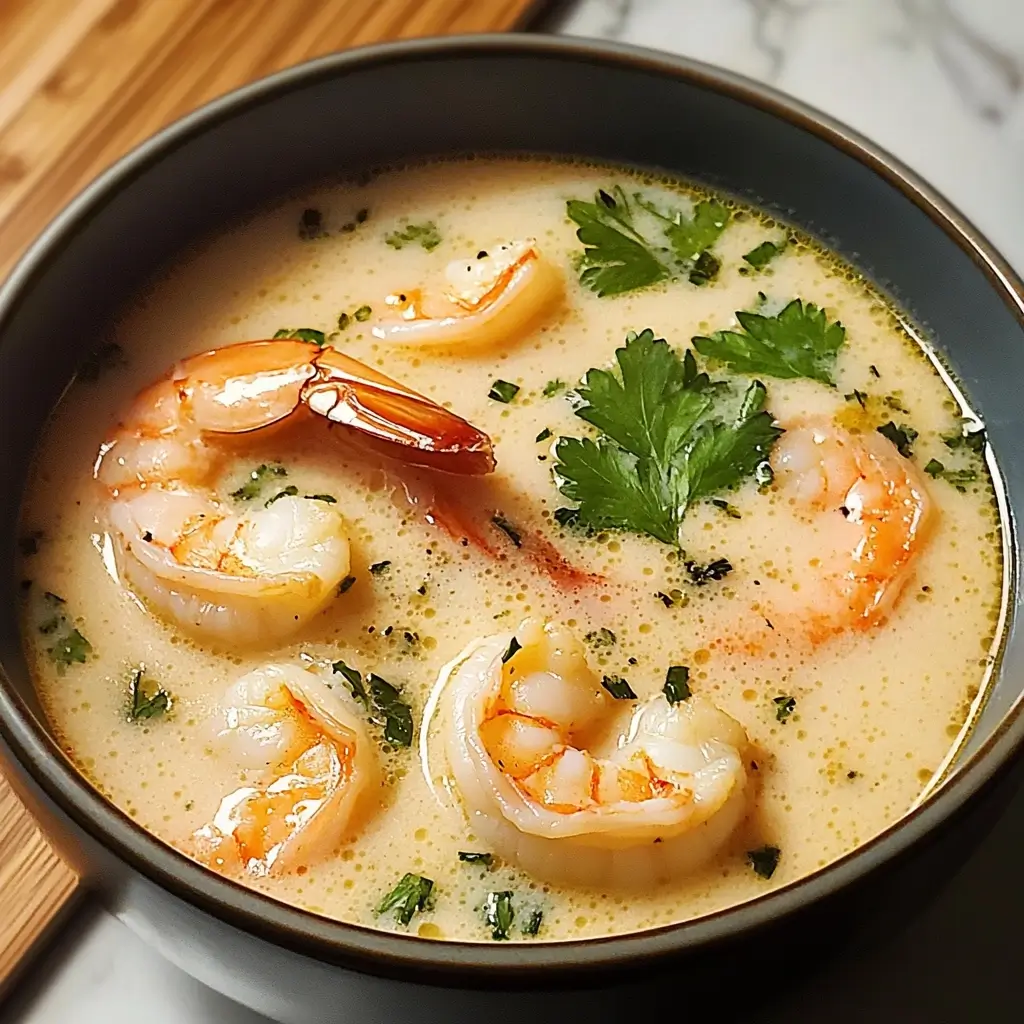This Thai Coconut Soup with Shrimp, or Tom Kha Goong as it’s lovingly called in Thailand, has become an absolute sensation in our household. The first time I made it, the aroma alone had everyone drifting into the kitchen, intrigued. The moment they tasted that first spoonful – a harmonious blend of creamy coconut, zesty lime, fragrant lemongrass and galangal, with a gentle kick of chili and the delightful chewiness of perfectly cooked shrimp – it was love at first bite. My kids, who can be notoriously picky, ask for “that yummy coconut soup” on a weekly basis now. It’s not just a meal; it’s an experience – a vibrant, comforting bowl that transports you straight to the bustling street food stalls of Bangkok or a serene Thai beach. It’s surprisingly easy to whip up on a weeknight yet sophisticated enough to impress dinner guests. The balance of sweet, sour, salty, and spicy is pure culinary magic, and I’m thrilled to share my version of this beloved classic with you.
Ingredients for Authentic Thai Coconut Soup with Shrimp (Tom Kha Goong)
This recipe aims for authenticity while being accessible. The quantities below will yield a generous portion, perfect for sharing or satisfying a hearty appetite.
- For the Soup Base & Aromatics:
- Coconut Milk: 2 cans (13.5 oz / 400ml each) full-fat, good quality (this is key for creaminess)
- Chicken or Vegetable Broth: 2 cups (480ml) low-sodium
- Lemongrass: 2-3 stalks, tough outer layers removed, cut into 2-inch pieces and bruised (smashed with the side of a knife)
- Galangal: 2-inch piece (about 20-30g), thinly sliced (fresh is best; dried can be used but needs rehydration, frozen is a good alternative)
- Kaffir Lime Leaves: 6-8 fresh or frozen leaves, torn or lightly bruised (if using dried, use double the amount and rehydrate briefly)
- Shallots: 2-3 small, thinly sliced (optional, but adds depth)
- Thai Bird’s Eye Chilies: 1-3 (or more to taste), bruised or thinly sliced (adjust to your spice preference, can be omitted)
- Main Ingredients & Vegetables:
- Shrimp: 1 lb (450g) large shrimp, peeled and deveined, tail on or off as preferred
- Mushrooms: 8 oz (225g) – traditionally straw mushrooms, but oyster, shiitake (stems removed), or even cremini/button mushrooms, sliced or quartered, work well.
- Seasoning & Flavor Enhancers:
- Fish Sauce (Nam Pla): 2-3 tablespoons (adjust to taste – this is your primary salting agent)
- Fresh Lime Juice: 2-3 tablespoons (from 1-2 limes, adjust to taste – for that essential sour note)
- Palm Sugar or Granulated Sugar: 1-2 teaspoons (adjust to taste – to balance the flavors)
- Thai Chili Paste (Nam Prik Pao): 1-2 teaspoons (optional, for added depth, color, and mild sweetness/spiciness)
- Garnish (Essential for Freshness):
- Fresh Cilantro: A generous handful, roughly chopped
- Fresh Thai Basil Leaves: A few leaves (optional, but adds another layer of aroma)
- Lime Wedges: For serving
- Red Chili Flakes or Sliced Red Chili: For extra heat, if desired
- A Drizzle of Chili Oil: For visual appeal and an extra kick (optional)
Step-by-Step Instructions: Crafting Your Perfect Tom Kha Goong
Follow these steps carefully to achieve a beautifully balanced and aromatic Thai Coconut Soup. Remember that tasting and adjusting seasoning at the end is crucial!
- Prepare the Aromatics:
- Take your lemongrass stalks. Remove the tough, dry outer layers until you reach the paler, more tender core. Cut off the very bottom root end. Slice the stalks into 2-inch pieces. Using the flat side of a large knife or a pestle, firmly bruise or smash each piece. This helps release their fragrant oils.
- Peel the galangal if the skin is tough, then slice it thinly (about 1/8-inch thick). You don’t need to peel it if the skin is tender.
- Gently tear or bruise the kaffir lime leaves to release their aroma.
- If using shallots, peel and slice them thinly.
- For the Thai chilies, you can leave them whole and just bruise them for a milder heat, or slice them for more intense spice. Remember to wash your hands thoroughly after handling chilies.
- Build the Aromatic Broth:
- In a medium to large pot or Dutch oven, combine one can (13.5 oz / 400ml) of coconut milk and the chicken or vegetable broth.
- Add the prepared lemongrass, sliced galangal, torn kaffir lime leaves, and sliced shallots (if using).
- Bring this mixture to a gentle simmer over medium heat. Do not bring it to a rolling boil, especially after adding all the coconut milk, as high heat can cause it to separate or curdle. Simmer gently for 10-15 minutes. This allows the aromatics to infuse their wonderful flavors into the liquid. The kitchen should start smelling incredible at this point!
- Add Mushrooms and Cook:
- Add your chosen mushrooms (straw, oyster, shiitake, etc.) to the simmering broth. If using larger mushrooms, ensure they are sliced or quartered into bite-sized pieces.
- Continue to simmer for another 5-7 minutes, or until the mushrooms are tender and have absorbed some of the broth’s flavor.
- Incorporate Remaining Coconut Milk & Chili Paste (Optional):
- Stir in the second can (13.5 oz / 400ml) of coconut milk. This addition makes the soup richer and creamier.
- If you’re using Thai chili paste (Nam Prik Pao) for extra depth and a touch of sweetness and color, stir it in now until fully dissolved. Start with 1 teaspoon and add more if desired.
- Cook the Shrimp:
- Add the peeled and deveined shrimp to the soup. Shrimp cook very quickly, usually within 2-4 minutes. They are done when they turn pink and opaque and curl up. Be careful not to overcook them, as they can become tough and rubbery.
- If using Thai bird’s eye chilies for heat, add them now along with the shrimp.
- Season and Balance Flavors (The Most Important Step!):
- Once the shrimp are cooked, reduce the heat to low. It’s time to season your Tom Kha Goong. This is where the magic happens – balancing the salty, sour, sweet, and spicy notes.
- Start by adding 2 tablespoons of fish sauce, 2 tablespoons of fresh lime juice, and 1 teaspoon of sugar.
- Stir well and taste. This is crucial. Ask yourself:
- Is it salty enough? If not, add a little more fish sauce (try 1/2 teaspoon at a time).
- Is it sour/zesty enough? If not, add more lime juice (1/2 teaspoon at a time).
- Is it balanced – not too sour, not too salty? If it’s too sour or salty, a little more sugar can help balance it.
- Do you want more heat? If you haven’t added chilies or want more, now’s the time for a pinch of red chili flakes or a tiny bit more sliced fresh chili.
- Continue tasting and adjusting in small increments until the soup hits that perfect harmony of flavors that makes Tom Kha so addictive. It should be predominantly creamy and coconutty, with distinct notes of lime and galangal, a savory depth from the fish sauce, and a subtle sweetness.
- Prepare for Serving:
- Once you’re happy with the seasoning, turn off the heat.
- Traditionally, the lemongrass stalks, galangal slices, and kaffir lime leaves are left in the soup for continued infusion and visual appeal, but they are not typically eaten. You can inform your guests about this, or if you prefer, you can use a slotted spoon to remove and discard most of these larger aromatic pieces before ladling into bowls.
- Garnish and Serve:
- Ladle the hot soup into individual serving bowls.
- Garnish generously with fresh chopped cilantro and, if using, Thai basil leaves.
- Offer extra lime wedges on the side for those who like an extra citrusy kick.
- A small drizzle of chili oil or a sprinkle of red chili flakes can be added for those who desire more spice and visual flair.
- Serve immediately, typically with a side of steamed jasmine rice.
Nutrition Facts (Approximate)
- Servings: 4-6 servings
- Calories per serving (approximate, based on 4 servings): 380-450 kcal
Disclaimer: Nutritional information is an estimate and can vary significantly based on specific ingredient brands, quantities used, and any substitutions made. Full-fat coconut milk contributes significantly to the calorie and fat content, but it’s essential for the authentic taste and texture of Tom Kha.
Preparation and Cook Time
Understanding the time commitment helps in planning your meal, whether it’s a quick weeknight dinner or part of a more elaborate spread.
- Preparation Time: 15-20 minutes
- This includes washing and chopping vegetables, slicing aromatics, and peeling/deveining shrimp. If your shrimp is already prepped, this time will be shorter.
- Cook Time: 20-25 minutes
- This covers the simmering of aromatics, cooking mushrooms, and finally, cooking the shrimp.
- Total Time: Approximately 35-45 minutes
- From start to finish, you can have a delicious, restaurant-quality Thai Coconut Soup on your table in under an hour, making it a fantastic option for busy days.
How to Serve Your Delicious Thai Coconut Shrimp Soup
Serving Tom Kha Goong is an experience in itself, enhancing its delightful flavors and aromas. Here’s how to present it for maximum enjoyment:
- Individual Bowls: Ladle the hot soup into individual, preferably deep, soup bowls. This allows each person to enjoy the medley of ingredients.
- Garnish Generously: This is non-negotiable for authentic presentation and flavor!
- Fresh Cilantro: A must. Sprinkle a generous amount of freshly chopped cilantro over each bowl just before serving. Its bright, herbaceous notes cut through the richness of the coconut milk.
- Thai Basil (Optional): If available, a few fresh Thai basil leaves add a lovely anise-like fragrance.
- Lime Wedges: Always serve with extra lime wedges on the side. A final squeeze of fresh lime juice brightens all the flavors.
- Chili Accents: For those who love heat, offer thinly sliced red chilies (like bird’s eye or Fresno), a small bowl of red pepper flakes, or a drizzle of vibrant chili oil.
- Steamed Jasmine Rice: Tom Kha Goong is almost always served with a side of fluffy steamed jasmine rice. The rice provides a wonderful contrast in texture and helps to soak up the delicious, creamy broth. Diners can either spoon the soup over their rice or enjoy spoonfuls of rice between sips of soup.
- Inform About Aromatics: Remind your guests that the pieces of lemongrass, galangal, and kaffir lime leaves are typically not eaten but are left in for flavor. They can be pushed to the side of the bowl.
- Serve Immediately: The soup is best enjoyed piping hot, when the aromas are at their peak and the shrimp is perfectly tender.
- As Part of a Thai Meal: If you’re creating a larger Thai-inspired meal, Tom Kha Goong serves beautifully as a first course or alongside other dishes like Green Curry, Pad Thai, or fresh spring rolls. Its distinct flavor profile complements many other Thai specialties.
- Consider the Ambiance: While not essential, simple touches like Thai-inspired placemats or soft lighting can enhance the dining experience, making your homemade Tom Kha feel even more special.
Additional Tips for the Best Tom Kha Goong Experience
Elevate your Thai Coconut Soup from great to exceptional with these insider tips:
- Quality of Coconut Milk is Key: Don’t skimp on the coconut milk. Opt for full-fat, good-quality brands. Shake the can well before opening. The creaminess and richness of your Tom Kha heavily depend on this. Avoid “lite” or “reduced-fat” versions for the most authentic flavor and texture. Some chefs even recommend using the thick cream from the top of the can first to sauté aromatics, then adding the rest.
- Don’t Boil Vigorously After Adding All Coconut Milk: Once all the coconut milk is in, maintain a gentle simmer. Boiling it too hard, especially for extended periods, can cause the coconut milk to separate or “break,” resulting in a curdled texture rather than a smooth, creamy one. A gentle, loving simmer is your friend here.
- The Holy Trinity of Thai Aromatics – Don’t Substitute if Possible: Lemongrass, galangal, and kaffir lime leaves are the heart and soul of Tom Kha. While ginger is sometimes suggested as a galangal substitute, it has a very different flavor profile (spicier, less earthy and citrusy). If you absolutely cannot find fresh or frozen galangal, use it sparingly. Fresh or frozen kaffir lime leaves are far superior to dried, which lose much of their aroma. Asian markets or online retailers are your best bet for these essential ingredients.
- Taste and Adjust Religiously: The final seasoning stage is where you truly make the soup your own. The balance of salty (fish sauce), sour (lime juice), and sweet (sugar) is critical. Add these seasonings gradually, tasting after each addition. Trust your palate. The soup should dance on your tongue with a harmonious blend of these core Thai flavors.
- Don’t Overcook the Shrimp: Shrimp cook incredibly fast. Add them at the very end and cook only until they turn pink and opaque (usually 2-4 minutes). Overcooked shrimp become tough and rubbery, which can detract from the otherwise delicate and luxurious soup. If making ahead, prepare the soup base and only add and cook the shrimp just before serving.
Frequently Asked Questions (FAQ) about Thai Coconut Soup with Shrimp
Here are answers to some common questions you might have about making Tom Kha Goong:
- Q: What’s the difference between Tom Kha and Tom Yum soup?
- A: Both are iconic Thai soups, but they have distinct flavor profiles. Tom Kha (like this recipe) is characterized by its creamy coconut milk base, with galangal (“Kha”) being a dominant aromatic. It’s generally milder, richer, and has a balance of sour, salty, and slightly sweet notes. Tom Yum is typically a hot and sour soup with a clear or slightly creamy broth (sometimes with a touch of evaporated milk or coconut milk, but less so than Tom Kha). It prominently features lemongrass, kaffir lime leaves, galangal, and often a generous amount of chili, making it spicier and tangier.
- Q: Can I make this soup vegetarian or vegan?
- A: Absolutely! To make it vegetarian/vegan:
- Use vegetable broth instead of chicken broth.
- Substitute the shrimp with firm or extra-firm tofu (cubed and pan-fried or added directly), or use a medley of additional Asian mushrooms like enoki or king oyster.
- Replace fish sauce with a vegan fish sauce alternative, or use light soy sauce/tamari. If using soy sauce, you might need to adjust the amount and add a pinch more sugar or lime to balance the flavor, as it’s different from fish sauce. Start with a smaller amount and taste.
- A: Absolutely! To make it vegetarian/vegan:
- Q: I can’t find fresh galangal or kaffir lime leaves. What are the best substitutes?
- A: While fresh is best, here are alternatives:
- Galangal: Frozen galangal is an excellent substitute and often found in Asian markets. Dried galangal slices can work but need to be rehydrated in hot water for about 20-30 minutes before use; their flavor is less potent. Ginger is not a direct substitute as its flavor is quite different (more pungent and spicy vs. galangal’s piney, citrusy notes). If you must use ginger, use less and know the flavor will be altered.
- Kaffir Lime Leaves: Frozen leaves are a fantastic alternative to fresh. Dried kaffir lime leaves are the next best option; use double the amount and rehydrate them briefly in warm water or add them directly to the simmering broth. Lime zest (from 1-2 limes) can provide some citrus aroma in a pinch, but it lacks the unique perfume of kaffir lime.
- A: While fresh is best, here are alternatives:
- Q: How spicy is this soup, and can I adjust the heat level?
- A: The spiciness of this Tom Kha Goong recipe is highly adjustable. The heat comes primarily from the Thai bird’s eye chilies and optionally the Thai chili paste (Nam Prik Pao).
- For mild soup: Omit the fresh chilies entirely, or use just one, kept whole and bruised. Ensure your chili paste (if using) is mild.
- For medium heat: Use 1-2 chilies, bruised or roughly chopped.
- For spicy soup: Use 3 or more chilies, thinly sliced (including seeds for maximum heat).
You can always serve extra sliced chilies or chili flakes on the side for individuals to add to their own bowls.
- A: The spiciness of this Tom Kha Goong recipe is highly adjustable. The heat comes primarily from the Thai bird’s eye chilies and optionally the Thai chili paste (Nam Prik Pao).
- Q: How do I store and reheat leftovers?
- A: Let the soup cool to room temperature, then transfer it to an airtight container. Store it in the refrigerator for up to 3-4 days.
- To reheat: Gently reheat the soup on the stovetop over medium-low heat until warmed through. Avoid boiling it vigorously, as this can cause the coconut milk to separate and may overcook the shrimp further. If the shrimp are already perfectly cooked, you might even consider removing them, reheating the soup, and then adding the shrimp back in just to warm up. You may need to add a fresh squeeze of lime juice or a sprinkle of cilantro to brighten the flavors after reheating. Freezing is possible, but the texture of the coconut milk and shrimp might change slightly upon thawing.
- A: Let the soup cool to room temperature, then transfer it to an airtight container. Store it in the refrigerator for up to 3-4 days.

Authentic Thai Coconut Soup with Shrimp Recipe
Ingredients
- For the Soup Base & Aromatics:
- Coconut Milk: 2 cans (13.5 oz / 400ml each) full-fat, good quality (this is key for creaminess)
- Chicken or Vegetable Broth: 2 cups (480ml) low-sodium
- Lemongrass: 2-3 stalks, tough outer layers removed, cut into 2-inch pieces and bruised (smashed with the side of a knife)
- Galangal: 2-inch piece (about 20-30g), thinly sliced (fresh is best; dried can be used but needs rehydration, frozen is a good alternative)
- Kaffir Lime Leaves: 6-8 fresh or frozen leaves, torn or lightly bruised (if using dried, use double the amount and rehydrate briefly)
- Shallots: 2-3 small, thinly sliced (optional, but adds depth)
- Thai Bird’s Eye Chilies: 1-3 (or more to taste), bruised or thinly sliced (adjust to your spice preference, can be omitted)
- Main Ingredients & Vegetables:
- Shrimp: 1 lb (450g) large shrimp, peeled and deveined, tail on or off as preferred
- Mushrooms: 8 oz (225g) – traditionally straw mushrooms, but oyster, shiitake (stems removed), or even cremini/button mushrooms, sliced or quartered, work well.
- Seasoning & Flavor Enhancers:
- Fish Sauce (Nam Pla): 2-3 tablespoons (adjust to taste – this is your primary salting agent)
- Fresh Lime Juice: 2-3 tablespoons (from 1-2 limes, adjust to taste – for that essential sour note)
- Palm Sugar or Granulated Sugar: 1-2 teaspoons (adjust to taste – to balance the flavors)
- Thai Chili Paste (Nam Prik Pao): 1-2 teaspoons (optional, for added depth, color, and mild sweetness/spiciness)
- Garnish (Essential for Freshness):
- Fresh Cilantro: A generous handful, roughly chopped
- Fresh Thai Basil Leaves: A few leaves (optional, but adds another layer of aroma)
- Lime Wedges: For serving
- Red Chili Flakes or Sliced Red Chili: For extra heat, if desired
- A Drizzle of Chili Oil: For visual appeal and an extra kick (optional)
Instructions
- Prepare the Aromatics:
- Take your lemongrass stalks. Remove the tough, dry outer layers until you reach the paler, more tender core. Cut off the very bottom root end. Slice the stalks into 2-inch pieces. Using the flat side of a large knife or a pestle, firmly bruise or smash each piece. This helps release their fragrant oils.
- Peel the galangal if the skin is tough, then slice it thinly (about 1/8-inch thick). You don’t need to peel it if the skin is tender.
- Gently tear or bruise the kaffir lime leaves to release their aroma.
- If using shallots, peel and slice them thinly.
- For the Thai chilies, you can leave them whole and just bruise them for a milder heat, or slice them for more intense spice. Remember to wash your hands thoroughly after handling chilies.
- Build the Aromatic Broth:
- In a medium to large pot or Dutch oven, combine one can (13.5 oz / 400ml) of coconut milk and the chicken or vegetable broth.
- Add the prepared lemongrass, sliced galangal, torn kaffir lime leaves, and sliced shallots (if using).
- Bring this mixture to a gentle simmer over medium heat. Do not bring it to a rolling boil, especially after adding all the coconut milk, as high heat can cause it to separate or curdle. Simmer gently for 10-15 minutes. This allows the aromatics to infuse their wonderful flavors into the liquid. The kitchen should start smelling incredible at this point!
- Add Mushrooms and Cook:
- Add your chosen mushrooms (straw, oyster, shiitake, etc.) to the simmering broth. If using larger mushrooms, ensure they are sliced or quartered into bite-sized pieces.
- Continue to simmer for another 5-7 minutes, or until the mushrooms are tender and have absorbed some of the broth’s flavor.
- Incorporate Remaining Coconut Milk & Chili Paste (Optional):
- Stir in the second can (13.5 oz / 400ml) of coconut milk. This addition makes the soup richer and creamier.
- If you’re using Thai chili paste (Nam Prik Pao) for extra depth and a touch of sweetness and color, stir it in now until fully dissolved. Start with 1 teaspoon and add more if desired.
- Cook the Shrimp:
- Add the peeled and deveined shrimp to the soup. Shrimp cook very quickly, usually within 2-4 minutes. They are done when they turn pink and opaque and curl up. Be careful not to overcook them, as they can become tough and rubbery.
- If using Thai bird’s eye chilies for heat, add them now along with the shrimp.
- Season and Balance Flavors (The Most Important Step!):
- Once the shrimp are cooked, reduce the heat to low. It’s time to season your Tom Kha Goong. This is where the magic happens – balancing the salty, sour, sweet, and spicy notes.
- Start by adding 2 tablespoons of fish sauce, 2 tablespoons of fresh lime juice, and 1 teaspoon of sugar.
- Stir well and taste. This is crucial. Ask yourself:
- Is it salty enough? If not, add a little more fish sauce (try 1/2 teaspoon at a time).
- Is it sour/zesty enough? If not, add more lime juice (1/2 teaspoon at a time).
- Is it balanced – not too sour, not too salty? If it’s too sour or salty, a little more sugar can help balance it.
- Do you want more heat? If you haven’t added chilies or want more, now’s the time for a pinch of red chili flakes or a tiny bit more sliced fresh chili.
- Continue tasting and adjusting in small increments until the soup hits that perfect harmony of flavors that makes Tom Kha so addictive. It should be predominantly creamy and coconutty, with distinct notes of lime and galangal, a savory depth from the fish sauce, and a subtle sweetness.
- Prepare for Serving:
- Once you’re happy with the seasoning, turn off the heat.
- Traditionally, the lemongrass stalks, galangal slices, and kaffir lime leaves are left in the soup for continued infusion and visual appeal, but they are not typically eaten. You can inform your guests about this, or if you prefer, you can use a slotted spoon to remove and discard most of these larger aromatic pieces before ladling into bowls.
- Garnish and Serve:
- Ladle the hot soup into individual serving bowls.
- Garnish generously with fresh chopped cilantro and, if using, Thai basil leaves.
- Offer extra lime wedges on the side for those who like an extra citrusy kick.
- A small drizzle of chili oil or a sprinkle of red chili flakes can be added for those who desire more spice and visual flair.
- Serve immediately, typically with a side of steamed jasmine rice.
Nutrition
- Serving Size: One Normal Portion
- Calories: 380-450 kcal





